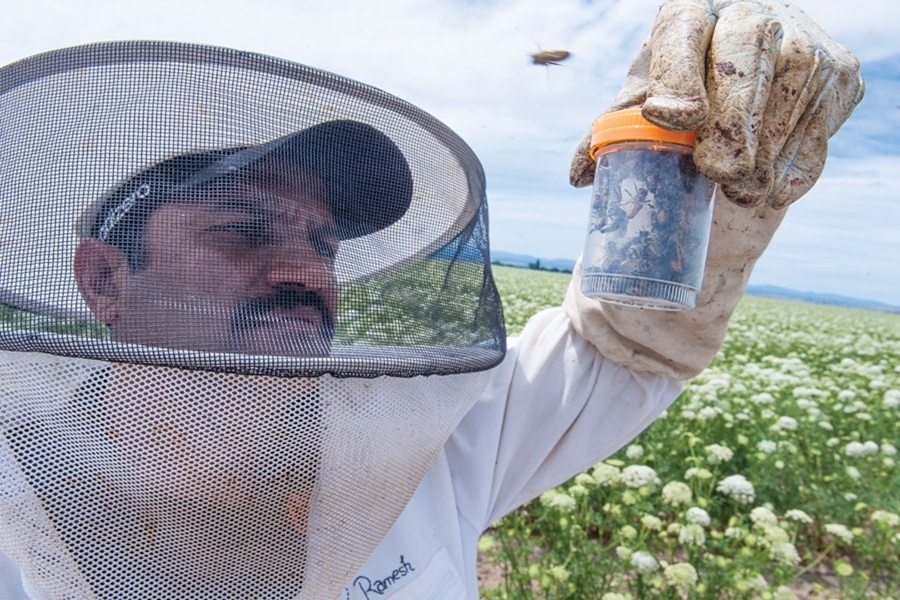The study will assess and address the causes of foulbrood disease, which is now killing honey bees at a rate that impacts crop pollination. Researcher at Oregon State University announced this week that they have received a $4.2 million grant from the U.S. Department of Agriculture’s National Institute of Food and Agriculture to fund a four-year four-state study on the causes and prevention of European foulbrood disease. The bacterial disease, which infects honey bees in the larval stage, was once only a minor nuisance for beekeepers. But in the last decade, the disease has become widespread enough to affect the pollination of specialty crops, including blueberries. “When bees go to pollinate blueberries, highbush blueberries, or some crops down the line, especially in springtime, we have seen more of this disease. In the past, we considered this disease minor because it used to go away after a month or so. But now it’s persisting for longer durations and sometimes it’s not going away,” says project director Ramesh Sagili, a professor in OSU’s College of Agricultural Sciences and an apiculturist with OSU Extension Service. Sagili says his research hasn’t put a dollar amount on the destruction caused by European foulbrood disease yet, but that Oregon specialty crops that require pollination in springtime are going to be the most heavily impacted. “Beekeepers in Oregon on average pollinate about five different crops in a year, so you see a cascading impact on pollination. If the colonies are not strong, then they will not do a good job pollinating. That’s why blueberry growers are concerned. There is also some indication of concern among almond growers. I think we are just seeing the beginning. That’s why we thought we should address this problem before it gets too bad.” Five researchers at OSU, along with researchers from Washington State University, University of California, Davis and Mississippi State University, will investigate the factors contributing to the increasing incidence of the disease, then share their findings with beekeepers and growers to inform and improve mitigation efforts. While the cause of European foulbrood disease’s increasing prevalence is yet unknown, Sagili says the research will look at changing environmental factors which could be impacting the way honey bees forage for food, and resulting in malnutrition putting bees at risk for the bacterial ailment. “When blueberries are in bloom in Oregon, it’s mostly rainy and cold. So that might impact bee foraging,” Sagili says. “If the weather is not great, they can’t forage and that could impact their nutritional environment inside the hive. And that would compromise their immune systems and they will have more infections. Once we figure that out, then we’ll come up with mitigation measures. We can tell beekeepers, ‘Okay, you have to feed them some protein supplement mixed with some pollen that could take care of the nutritional stress at that time.’ We can’t change any temperatures, of course, but at least we can do some things indirectly.” Researchers will follow honey bee hives as they are transported by commercial beekeepers to pollinate almonds and then blueberries across Washington, Oregon, California and Mississippi. They will tag 1,536 hives for ongoing observation, which includes checking the frames for signs of foulbrood, estimating colony populations, and surveying the microbiota of bees and larvae. When they see evidence of the disease, researchers will collect samples and send them back to the lab for genetic testing to identify new bacterial variants and assess whether certain strains of the bacteria are more virulent or pervasive than others. They will then monitor the colonies’ nutrition by installing pollen traps on the hives to collect pollen as the bees re-enter their hives. This will allow researchers to determine whether the quantity or diversity of pollen plays a role in hives’ susceptibility to foulbrood. Field work for the project will start in February in California, when beekeepers around the country bring their hives to pollinate almonds as one of the first crops of the year.
OSU to Study Prevalent Honey Bee Disease That’s Affecting Blueberry Production

OSU
Ramesh Sagili samples bees for diagnostics in a beekeeper suit.


